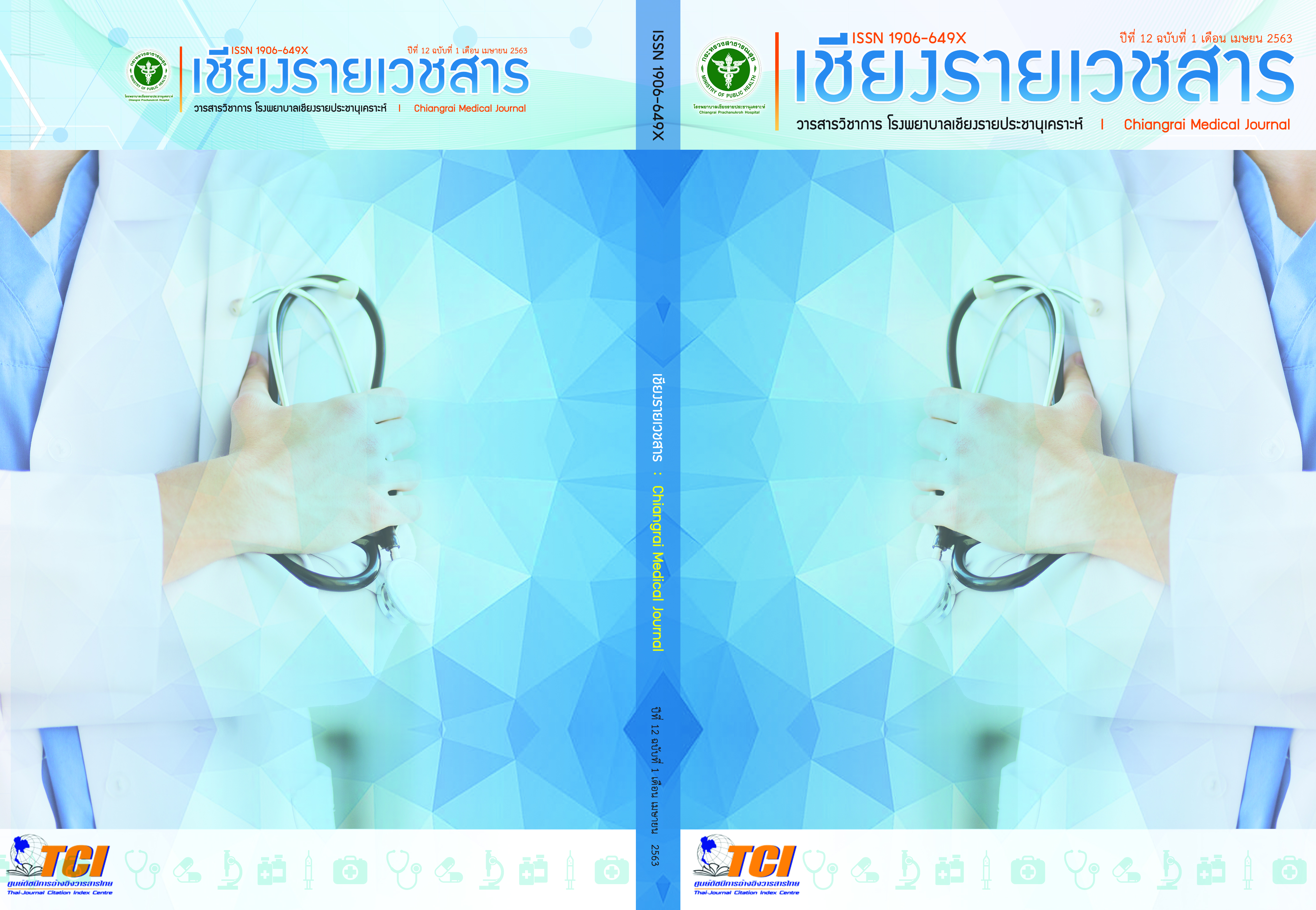ปัจจัยที่มีผลต่อระดับความรุนแรงของผู้บาดเจ็บและระบาดวิทยาของอุบัติภัยกลุ่มชนที่เกิดจากอุบัติเหตุจราจรในจังหวัดลำปาง
Main Article Content
บทคัดย่อ
ชื่อเรื่อง: ปัจจัยที่มีผลต่อระดับความรุนแรงของผู้บาดเจ็บและระบาดวิทยาของอุบัติภัยกลุ่มชนที่เกิดจากอุบัติเหตุจราจรในจังหวัดลำปาง
ที่มา: อุบัติภัยกลุ่มชนทางจราจรก่อให้เกิดการสูญเสียชีวิตและทุพลภาพ หากทราบปัจจัยที่มีผลต่อระดับความรุนแรงของผู้บาดเจ็บ อาจนำมาสู่การป้องกัน ลดความรุนแรงหรือเตรียมพร้อมตอบโต้เหตุจากอุบัติภัยกลุ่มชนได้
วิธีการศึกษา: เป็นการศึกษาย้อนหลัง เก็บข้อมูลตั้งแต่ 1 มกราคม 2556- 31 ธันวาคม 2562 เก็บข้อมูลจำนวนผู้บาดเจ็บ เพศ อายุ ช่วงเวลาที่เกิดเหตุ ประเภทยานพาหนะ และพื้นที่ที่เกิดเหตุ เปรียบเทียบลักษณะพื้นฐานของผู้บาดเจ็บจำแนกตามระดับความรุนแรง 4 กลุ่ม ได้แก่ expectant, immediate, urgent, และ delayed ตามลำดับ ตัวแปรบอกลักษณะใช้สถิติ Exact probability test, ตัวแปรต่อเนื่องใช้สถิติ one-way ANOVA วิเคราะห์ปัจจัยที่มีผลต่อระดับความรุนแรงโดยใช้ Multi-level ordered logistic regression model
ผลการศึกษา: มีอุบัติภัยกลุ่มชนทั้งสิ้น 96 เหตุ (ผู้บาดเจ็บ 661 ราย) จำนวนผู้บาดเจ็บ expectant , immediate, urgent, และ delayed ได้แก่ 56 (8.5%), 96 (14.5%), 249 (37.7%), 260 (39.3%) ตามลำดับ ส่วนใหญ่เป็นเพศชาย 334 (52.0%) ปัจจัยที่มีผลต่อระดับความรุนแรงของผู้บาดเจ็บได้แก่ อายุมากกว่า 45 ปี (†OR, 2.77; 95% CI, 1.66-4.65; p<0.001) เกิดขึ้นในช่วงเวรดึก (†OR, 3.36; 95% CI, 1.22-9.30; p=0.019) รถกระบะเป็นเหตุหลัก (†OR, 2.15; 95% CI, 1.01-4.59; p=0.047) พื้นที่โซนเหนือ (†OR, 3.41; 95% CI, 0.86-13.44; p=0.080) และเกิดขึ้นในวันหยุด (†OR, 2.07; 95% CI, 0.95-4.47; p=0.065)
สรุป: เพื่อป้องกันและลดระดับความรุนแรงของผู้บาดเจ็บในอุบัติภัยกลุ่มชนทางจราจร ควรเฝ้าระวัง ผู้โดยสารที่มีอายุมาก ขับขี่ในยามค่ำคืน การใช้รถกระบะ และการสัญจรในพื้นที่ภูเขาสูงชัน
Article Details
เอกสารอ้างอิง
2. American Medical Association, National Disaster Life Support Foundation. (2007). All-hazards course overview and disaster paradigm. In: Dallas CE, Coule PL, James JJ, editors. Basic disaster life support TM provider manual version 2.6. New York: Lippincott, 2007. p.1-27.
3. American Medical association, American Public Health Association. Improving health system preparedness for terrorism and mass casualty events [Internet]. n.p.: n.p.; 2007. [cited 2019 Dec 24]. Available from: file:///C:/Users/Admin/Downloads/cdc_6891_DS1%20(7).pdf
4. Lennquist S. Education and training in disaster medicine. Scand J Sur. 2005;94(4):300–10.
5. Branas CC, Sing RF, Perron AD. A case series analysis of mass casualty incidents. Prehosp Emerg Care. 2000;4(4):299–304.
6. Eastman AL, Rinnert KJ, Nemeth IR, Fowler RL, Minei JP. Alternate site surge capacity in times of public health disaster maintains trauma center and emergency department integrity: Hurricane Katrina. J Trauma. 2007;63(2):253–7.
7. Irvin CB, Atas JG. Management of evacuee surge from a disaster area: solutions to avoid non-emergent, emergency department visits. Prehosp Disaster Med. 2007;22(3):220–3.
8. Sloan HM. Responding to a multiple-casualty incident: room for improvement. J Emerg Nurs. 2011;37(5):484–6.
9. Clarkson L, Williams M. EMS, Mass Casualty Triage. [Updated 2019 Feb 25]. In: StatPearls [Internet]. Treasure Island (FL): StatPearls Publishing; 2019 Jan. Available from: http://www.ncbi.nlm.nih.gov/books/NBK459369/
10. World Health Organization. Mass casualty management: systems strategies and guidelines for building health sector capacity. Geneva: WHO, 2007.
11. Castro Delgado R, Naves Gómez C, Cuartas Álvarez T, Arcos González P. An epidemiological approach to mass casualty incidents in the Principality of Asturias (Spain). Scand J Trauma Resusc Emerg Med. 2016; 24:18.
12. Shah MN, Cushman JT, Davis CO, Bazarian JJ, Auinger P, Friedman B. The epidemiology of emergency medical services uses by children: an analysis of the National Hospital Ambulatory Medical Care Survey. Prehosp Emerg Care. 2008;12(3):269–76.
13. Schenk E, Wijetunge G, Mann NC, Lerner EB, Longthorne A, Dawson D. Epidemiology of mass casualty incidents in the United States. Prehosp Emerg Care. 2014;18(3):408–16.
14. World Health Organization. World report on road traffic injury prevention [Internet]. Geneva:WHO; 2004 [Cited 2019 Nov,25 ]. Available from: https://www.who.int/violence_injury_prevention/publications/road_traffic/world_report/en/


